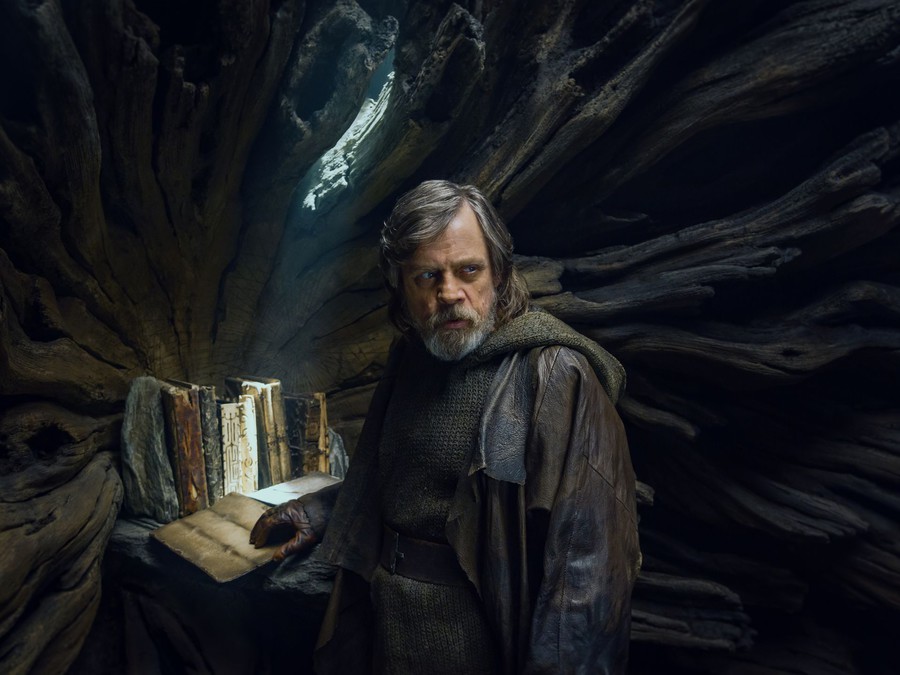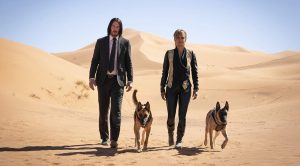Two films into a new trilogy, and three films into the new Disney era in a galaxy far, far away, audiences have yet to get something completely new from the creative team at Lucasfilm. The Force Awakens, while undeniably familiar and derivative, worked as a reinvigoration of the franchise. Rogue One provided an intriguing expansion of mythos, even if its characters fell flat. Still, both of the films dealt in the familiar: The Force Awakens in its structure and story, Rogue One in its subject material. Now, writer and director Rian Johnson has a daunting task in front of him: moving the saga forward with new characters while still honoring the franchise’s history and building on the foundation set by J.J. Abrams.
Perhaps the biggest issue with The Last Jedi is that by the time the film finally finds its feet, a significant portion of the two-and-a-half hour runtime has passed. The opening of the film picks up right where The Force Awakens left off. Johnson immediately thrusts the viewer into the middle of a frantic action sequence involving a Resistance evacuation in the face of a First Order attack. The scene should work as a fast start to the film, but it gets bogged down by too many conveniences: Poe Dameron (Oscar Isaac) is able to disable an entire ship single handedly, and the Resistance lines up a group of bombers, yet is able to destroy part of the First Order fleet with just one. Moreover, the lack of imposing villains undermines any sort of stakes the film tries to establish.
What worked so well about the Empire in the original trilogy was that the filmmakers were fully committed to making them as threatening as possible. Imperial underlings who worked in constant fear of Darth Vader were written and performed as soberly and seriously as possible. Here, Johnson seems more interested with using the First Order’s ethos as a punchline. Domhnall Gleeson reprises his role as General Hux, and his character is laughably unintimidating. He gets humiliated multiple times over for the sake of a joke, and Gleeson seems determined to play the character as over-the-top as possible. Inconsistent writing undermines the supposed antagonists of the film. The lack of a real threat from the First Order detracts from what is supposed to be one of the two major storylines of the film.
After the grand opening action sequence concludes, the Resistance finds itself caught in a chase that spurs the weakest part of the whole film. John Boyega reprises his role as Finn, and he, along with a new character named Rose, played by Kelly Marie Tran, are charged with locating a hacker who can help the Resistance escape from the pursuit of the First Order. The pair venture to a lavishly designed casino in Canto Bight, located on a planet in some corner of the galaxy. The production and creature design in the casino is undoubtedly inventive, but the sequence sticks out like a sore thumb. Johnson attempts to give it some gravitas by introducing a subplot about animal cruelty, but Finn and Rose accomplish their task so easily that the whole sequence loses its purpose. Moreover, Benicio del Toro gets surprisingly little to do, as his character feels more like a plot mechanic than anything else. The attempt at moral ambiguity in a Star Wars film is commendable, but del Toro is underserved by a script that reduces him to a device that simply moves the story along. With the longest runtime of any Star Wars film yet, Finn and Rose’s mission, combined with del Toro’s convenience to the plot, just feels like unnecessary bloat.
One of the biggest weaknesses of the film is that the Resistance never really feels like it gets its due. Carrie Fisher does very little in her final performance as Leia, although just seeing her on screen will send shivers down the viewer’s spine. It’s clear that the filmmakers were planning on making Episode IX Leia’s story, which left them at a loss when Fisher tragically passed away in late 2016. Fisher doesn’t carry the film the way that Harrison Ford did for The Force Awakens, as it is clear that this is Mark Hamill’s movie. But there are heartfelt moments towards the end that pay tribute to Fisher’s legacy without ever feeling overwrought. Her rapport with Poe Dameron is especially enjoyable. Dameron gets a surprisingly effective character arc, as he moves from hot headed ace pilot to a more rational leader. It’s a role that may not completely befit an actor of Isaac’s talents, but he relishes the part and plays it with an aplomb reminiscent of another cocky pilot from the Star Wars universe.
It’s commendable that Johnson attempts to do so much with the film. There’s the balancing of past characters and departures, along with the introduction of new ones. (Laura Dern’s vice-admiral isn’t in the film for long, but her poised performance deserves a mention.) While the film has structural issues, Johnson’s direction is masterful as he provides several gorgeous shots that show off the splendor of the Star Wars universe. His writing does suffer from an over-reliance on punchy one-liners and filler, along with the fact that he has to juggle so many characters, but the film never feels weighed down by its sheer scope. Johnson’s keen sense for visuals is on the full display, and there are many jaw-droppingly gorgeous moments.
Fans irritated by how derivative The Force Awakens felt will be happy to know that despite some similar strokes as The Empire Strikes Back, The Last Jedi feels like a massive step away from the familiar. The most compelling plot of the film is the relationship between Luke Skywalker, Rey, and Kylo Ren. The storyline starts right where the final shot of The Force Awakens left Luke and Rey on Ahch-To, and the training between Luke and Rey is obviously reminiscent of the training between Luke and Yoda in Empire. But the difference here is that Johnson weaves in a parallel between Luke and Rey and Kylo Ren and his master, Snoke. The interplay between Luke and Rey is brilliantly done: Daisy Ridley continues to grow into her character, and she manages to convey the inner struggle Rey is facing in a subtle and compelling manner.
After receiving approximately 30 seconds of screen time in The Force Awakens, Mark Hamill gets the most to do out of the members of the original cast, and he quickly dispels any concerns about his age or acting range. Make no mistake: this is not the heroic Luke Skywalker fans got in Return of the Jedi. Hamill’s Luke is a broken man who is stricken with guilt and has rejected the galaxy’s cries for help. Johnson shows no fear by diving headfirst into the moral ambiguity surrounding the Jedi, the Sith, and the Force, and Hamill aptly plays an extremely conflicted Luke. Some of the film’s best moments come from Hamill’s anchoring performance, and the film even raises intriguing questions about the morality of heroism and the Great Man Theory. These surprisingly mature themes help The Last Jedi find its feet towards the middle of the second act, before Johnson pulls the film together for an epic finale.
On the other side of the Jedi/Sith equation is Kylo Ren, and Adam Driver is nothing short of brilliant in his performance. Ren’s emotional volatility carries over from The Force Awakens, but the character still grows organically. Johnson is sure not to keep Rey and Ren apart for too long, as he introduces a plot device that allows the two to have conversations through the Force. The mechanics are a little dodgy, but seeing Ridley and Driver go back and forth is more than worth it. The only flaw in Ren’s storyline is that Snoke, portrayed via motion-capture by Andy Serkis, gets little development or motivation as his master and mentor. Any mystery surrounding Snoke’s background quickly dissipates in favor of a villain with tired and all-too-familiar motivations. Emperor Palpatine he is not. Still, the moments when Ren and Rey interact are some of the film’s best and most intense, making Snoke’s shortcomings forgivable.
The two storylines eventually converge, and when they do, the film hits its stride. The final showdown is nothing short of epic, and it remains character focused and driven as conflicts that have been building for two films come to a head. It’s interesting that The Last Jedi feels like a conclusion, rather than a continuation of the saga, and that fact will leave fans satisfied. Unlike the preceding films, The Last Jedi isn’t afraid to be bold, and the result is a film that feels like one half of a great Star Wars movie and one half of a mediocre one. But The Last Jedi moves away from the nostalgia of previous films directing the audience and the characters in a new direction. If nothing else, this makes the film one that demands repeated viewings to fully appreciate its strengths and flaws. It’s unclear where the saga will go in Episode IX, but perhaps that uncertainty will bode well for telling a compelling and original Star Wars story.





